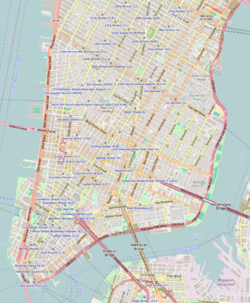Stephen Van Rensselaer House | |
 | |
| Location | 149 Mulberry Street, New York, New York |
|---|---|
| Coordinates | 40°43′8″N73°59′53″W / 40.71889°N 73.99806°W |
| Built | c.1816 |
| Architectural style | Federal |
| NRHP reference No. | 83001751 [1] |
| Significant dates | |
| Added to NRHP | June 16, 1983 |
| Designated NYCL | February 11, 1969 |
The Stephen Van Rensselaer House is at 149 Mulberry Street between Grand and Hester Streets in the Little Italy neighborhood of Manhattan in New York City. It was built c. 1816 in the Federal style by Stephen Van Rensselaer III. It was originally located on the northwest corner of Mulberry and Grand, but in 1841 was moved down the block to its current location. The two-story dormered house is typical of Federal-style row houses which were common at the time in Manhattan below 14th Street. [2] [3] [4]
Contents
The house was designated a New York City landmark in 1969 and was added to the National Register of Historic Places in 1983.





